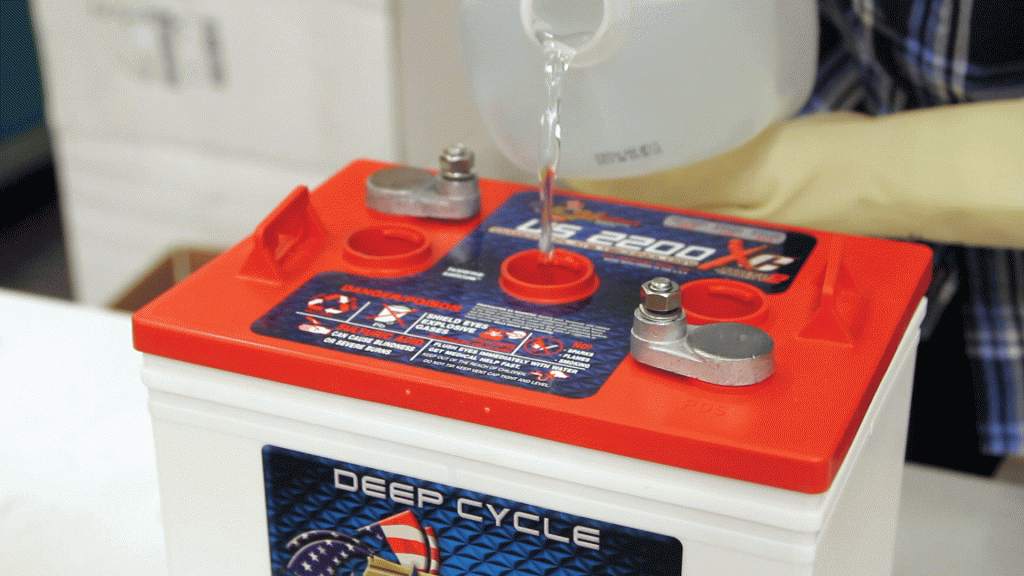Fred Wehmeyer, Senior Vice President of Engineering
US Battery Manufacturing
Businesses that use flooded lead-acid batteries for a variety of applications already know the importance of charging and adding water for optimum performance. Flooded lead-acid batteries are still the most cost effective means to power a variety of vehicles such as golf cars, platforms, cranes and more, but are also great for storing power used in off-grid and partial grid applications. Although these batteries are cost effective, anyone who has had to purchase a new set of them knows how expensive that can be. By making the batteries last longer, users can save a significant amount of money and reduce annual operating costs.
 The best way to extend the service life of flooded lead-acid batteries is to create a routine maintenance schedule. Charging, watering and performing an equalization charge are all critical procedures that should be performed on a routine basis. By following these tips, you’ll ensure that the procedures are done correctly and that the service life of your flooded lead-acid batteries is maximized.
The best way to extend the service life of flooded lead-acid batteries is to create a routine maintenance schedule. Charging, watering and performing an equalization charge are all critical procedures that should be performed on a routine basis. By following these tips, you’ll ensure that the procedures are done correctly and that the service life of your flooded lead-acid batteries is maximized.
Safety First: Be sure to wear gloves, eye protection and work in a well ventilated area. Turn off the battery charger and any electrical loads when servicing the batteries.
Check Vent Caps: Open the battery compartment of the vehicle. Many times the batteries are hard to access and the vent caps may not have been reinstalled properly after watering. Make a visual inspection to ensure the vent caps on top of the batteries are properly seated. The vent caps contain spark arrestors to help prevent ignition of gases inside the batteries. Always keep them in place except during watering and specific gravity measurements.
Clean The Terminals: If you spot corroded terminals, use a solution of baking soda and water to neutralize any stray acid deposits. When brushing the terminals, use a wire brush with a wooden or plastic handle to prevent accidental arcing. Then rinse the area with water and dry with a clean cloth. Do not allow any of the solution to enter the cells of the battery.
Check Connections: Always check the terminal connections to ensure they are tight but do not over-tighten them. Recommended terminal torque is 100 inch-pounds or just 15 to 18 pounds on the end of a 6 inch wrench. Use only insulated tools or wrap them with electrical tape to prevent accidental arcing. Follow up with a corrosion inhibitor or silicone spray on the terminals to resist corrosion.
Check Electrolyte Levels: Some electrolyte is lost during each charge cycle, so it’s important to make sure the electrolyte is at the proper level; about 1/4 inch below the bottom of the fill-well. Check it every two to four weeks depending on the amount of use.
Add Water: Flooded lead-acid batteries will always need water. Use these watering techniques to obtain the best results:
1. Always charge the battery before watering but visually verify the electrolyte level is above the plates before charging.
2. Use caution when removing the vent caps to prevent acid splatter.
3. Use only distilled or de-ionized water.
4. Use a watering gun or pitcher to fill each cell to prevent over-watering (never use a
water hose).
5. Water all cells evenly and replace the battery vent caps assuring each one is properly installed and seated.
Perform an Equalization Charge: An equalization charge is an extended charge after the normal charge has been completed. It causes additional gassing, which is essential for mixing the electrolyte to prevent electrolyte stratification. Perform an equalization charge after the first discharge and recharge (cycle), and once every 30 days during regular use. Be sure to check the battery manufacturer’s recommendations for proper charging to make sure the correct charger is being used.
1. If your charger is equipped with an automatic equalizing mode, make sure the charger is connected and powered up long enough to complete a full equalization charge.
2. If your charger is not equipped with an automatic equalization mode, ensure the charger has completed a full charge and then restart the charger by disconnecting AC power and reconnecting. The charger should restart and extend the charge time by 1 to 3 hours.
Make these maintenance procedures routine and you’ll see a dramatic increase in the life of your flooded lead-acid batteries as well as their overall performance.
Fred Wehmeyer is the Senior VP of Engineering at US Battery Manufacturing and has a BS Degree in Electrochemistry as well as more than 40 years of experience in the battery industry.
For more information, please contact US Battery at http://usbattery.com.







